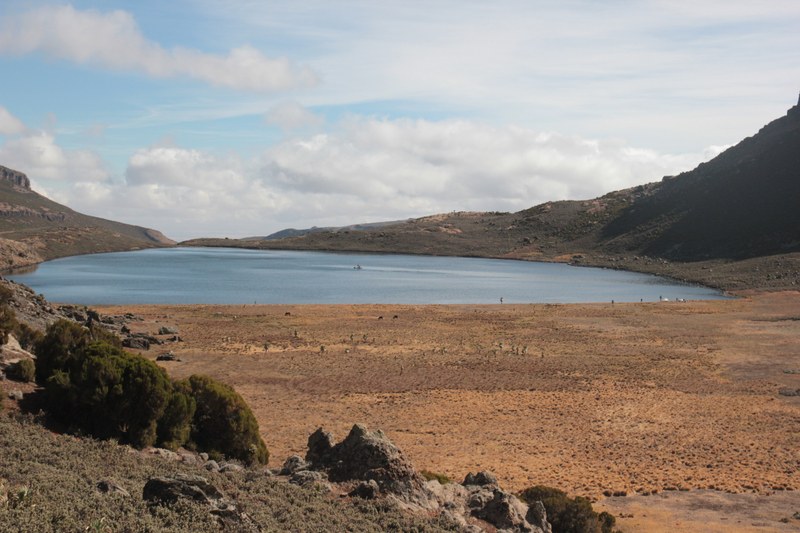Main Content
P5 - Paleoclimatology
P5 was part of the research group in Project Phase I (2016-2019) and joins the research group as cooperation partner with their own DFG research project in Project Phase II (2019-2022)
PI: Michael Zech | Seifu Kebede, Sileshi Nemomissa
PhD-Students: Bruk Lemma, Lucas Bittner
Overview
Our subproject contributes to the reconstruction of the paleoclimatic conditions of the Bale Mountains by applying biomarker as well as stable oxygen (180/160) and hydrogen (2H/1H) isotope analyses to precipitation, plant, soil and sediment samples. (i) Studying the isotope signature of modern-day precipitation is essential for better understanding the modern-day atmospheric circulation patterns and thus for a robust interpretation of sedimentary δ180 and δ2H records. (ii) Our biomarker and isotope proxies are furthermore calibrated along altitudinal climate transects. (iii) Finally, the application of our proxies to jointly studied paleoenvironmental/-climate sedimentary archives allow a direct comparison of the paleoclimate history of the Bale Mountains with the vegetation, fire and human history as reconstructed by other subprojects (namely P2 Anthrosols and Intensity of Human Occupation and P4 Paleoecology).
Achievements
1. Our monitoring of δ2H/δ18O of modern-day precipitation in the Bale Mts revealed the existence of a pronounced altitude effect as well as a pronounced inner-annual/seasonal amount effect. In combination with trajectory studies and a literature review, our results challenge, however, the existence of an inter-annual amount effect and respective interpretations of sedimentary δ180 and δ2H records.
2. In close collaboration with P2 we found evidence for degradation strongly affecting plant-derived lignin phenol, n-alkane and sugar biomarkers. This challenges vegetation including Erica reconstructions in the Bale Mountains based on biomarkers. Moreover, our results demonstrate that plant-derived leaf wax and sugar biomarkers do not reflect
δ2H/δ18O of precipitation, but rather δ2H/δ18O of leaf water that is enriched due to evapotranspiration.
3. Late Glacial-Holocene sedimentary cores were retrieved jointly with other subprojects from
several study sites. In lake Garba Guracha, the δ18Osugar record clearly reflects lake evaporation history. Strikingly, lake level lowstands (reflecting at least seasonal precipitation minima) in most of the archive coincide with charcoal maxima. The δ2Halkane/δ18Osugar results of the last 2 ka almost perfectly match modern day Garba Guracha lake water except for the Little Ice Age (LIA), for which our isotope results strongly point to very humid climatic conditions. Excitingly, the LIA seems to have been a period of human abandonment of the Garba Guracha catchment according to faecal fungal spore results of subproject P4.


Figure 1: View of Lake Garba Guracha, Ethiopia Figure 2: Drilling a core in the Wolf Station Depression on the Sanetti Plateau, Ethiopia
Publications
Bittner, L.; Gil-Romera, G.; Grady, Dai; Lamb,H. F.; Lorenz, E.; Weiner, M. et al. (2021): The Holocene lake-evaporation history of the afro-alpine Lake Garba Guracha in the Bale Mountains, Ethiopia, based on δ18O records of sugar biomarker and diatoms. In: Quaternary Research, S. 1–14.
DOI: 10.1017/qua.2021.26
Lemma, B., Bittner, L., Glaser, B., Kebede, S., Nemomissa, S., Zech, W., Zech, M. (2021): δ2Hn-alkane and δ18Osugar biomarker proxies from leaves and topsoils of the Bale Mountains, Ethiopia, and implications for paleoclimate reconstructions. Biogeochemistry.
DOI: 10.1007/s10533-021-00773-z
Lemma, B.; Seifu Kebede, G.; Nemomissa, S.; Otte, I.; Glaser, B. & Zech, M. (2020): Spatial and temporal 2H and 18O isotope variation of contemporary precipitation in the Bale Mountains, Ethiopia. Isotopes in Environmental and Health Studies 56(1), 1-14.
DOI: 10.1080/10256016.2020.1717487
Lemma, B.; Grehl, C.; Zech, M.; Mekonnen, B.; Zech, W.; Nemomissa, S.; Bekele, T. & Glaser, B. (2019): Phenolic Compounds as Unambiguous Chemical Markers for the Identification of Keystone Plant Species in the Bale Mountains, Ethiopia. Plants 8(7), 1-15.
DOI: 10.3390/plants8070228
Lemma, B.; Mekonnen, B.; Glaser, B.; Zech, W.; Nemomissa, S.; Bekele, T.; Bittner, L. & Zech, M. (2019): Chemotaxonomic patterns of vegetation and soils along altitudinal transects of the Bale Mountains, Ethiopia, and implications for paleovegetation reconstructions – Part II: lignin-derived phenols and eaf-wax-derived n-alkanes. E&G Quaternary Science Journal 68, 189-200.
DOI: 10.5194/egqsj-68-189-2019
Bittner, L.; Lemma, B. (2018); Mekonnen, B.; Glaser, B.; Zech, M. & Zech, W.: First biomarker and stable isotope results from afro-alpine Lake Garba Guracha, Bale Mountains, Ethiopia - potential for paleovegetation and paleoclimate reconstructions. Geophysical Research Abstracts 20, 1-1.
Bittner, L.; Glaser, B.; Lemma, B.; Zech, M.; Zech, W. & Mekonnen, B. (2018): Poster: First biomarker and stable isotope results from afro-alpine Lake Garba Guracha, Bale Mountains, Ethiopia - potential for paleovegetation and paleoclimate reconstructions. Presented at Bale, international.
Gil-Romera, G.; Gelaw, M.F.; Renken, D.; Bittner, L.; Grady, D.; Lamb, H.; Lemma, B.; Zech, M. & Miehe, G. (2018) . Long-term fire regimes define Afroalpine and Afromontane vegetation in tropical mountains: the case of the Bale Mountains, Ethiopia. Presented at IPA-IAL Joint Meeting, Stockholm,Sweden.
Lamb, H.; Bittner, L.; Davies, S.; Gelaw, M.F.; Gil-Romera, G.; Grady, D.; Lemma, B.; Miehe, G. & Zech, M. (2018). Garba Guracha revisited: testing the Mountain Exile Hypothesis. Presented at AFQUA, Nairobi,Kenya.
Zech, M.; Tuthorn, M.; Hepp, J.; Zech, R. (2018); Rozanski, K. & Glaser, B. : Compound-specific oxygen isotope (δ18O) analysis of sugar biomarkers in lacustrine sediments – rationale, first applications and perspectives for future research. Presented at IPA-IAL Joint Meeting, Stockholm,Sweden
PhD Thesis
Lemma, Bruk (2021): Potential and limitations of biomarkers and stable isotopes for chemotaxonomy and (paleo-)climate research in the Bale Mountains, Ethiopia







